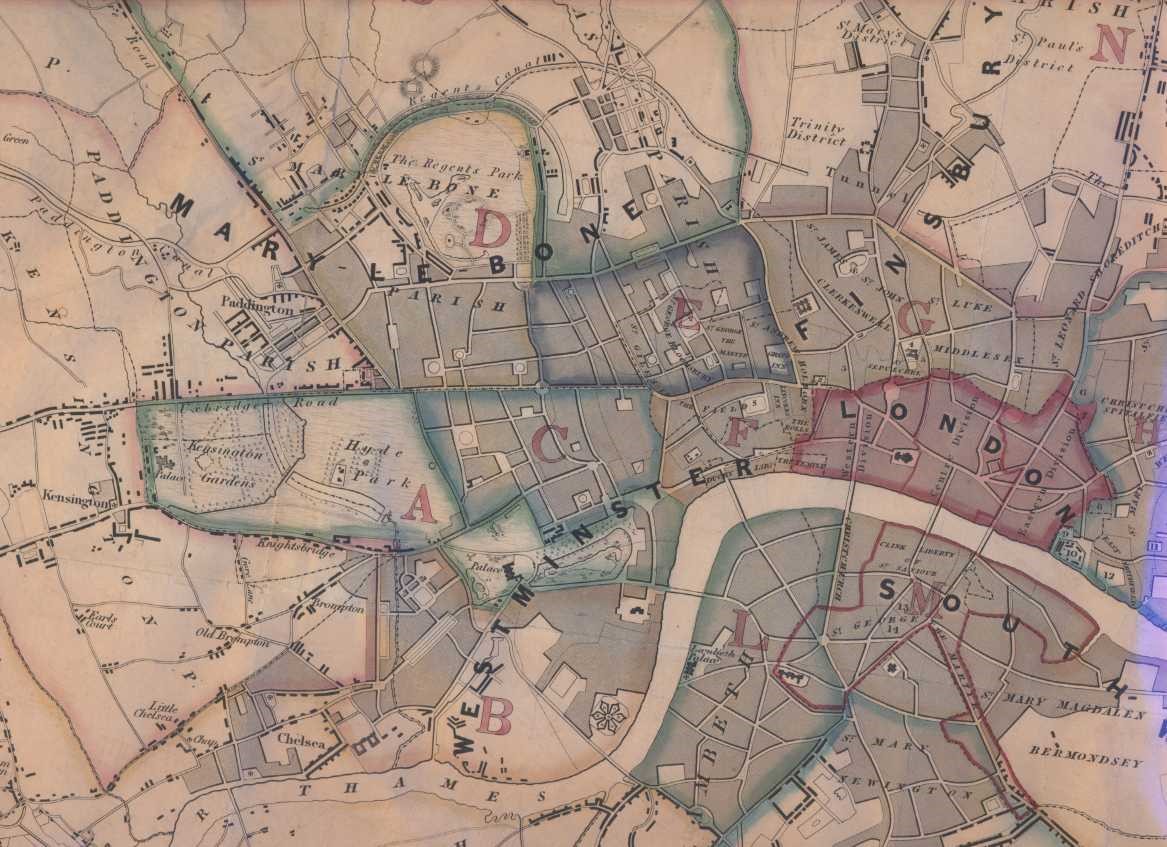
Back Home 175 years ago Stories from Scotland Yard About Us Contact Us
Divisions in 1860s 1880-1896 1903-1920 1921-1929 1931-1933 1946-1958 1965 1985-1986 1993-1994 2000 2018-2019 Top
The early Metropolitan Police District
This map is part of an illustration within the Reform Bill, and shows the boundaries of some of the Divisions of the Metropolitan Police in 1837.
 |
The first Divisions were created in a period between September 1829 and May 1830.
21 September 1829
| The first six Divisions were formed. The new recruits were sometimes referred to collectively as Ďcompaniesí, using familiar military terms. Their first patrols were on the evening of Friday 25 September 1829. They made use of some watch houses formerly occupied by parish constables, and occupied a number of other buildings that were taken into use as police stations. | |
| A Whitehall | Headquarters
at Great Scotland Yard
2 Gardinerís Lane (from mid-1830; King Street from 1847) |
| B Westminster
(2nd company) |
New Way,
Tothill Street
Roberts Buildings, Ebury Square (Gerald Road from 1845) |
| C St Jamesís | 10 Little Vine
Street
Dean Street, Soho Greek Street Great Marlborough Street |
| D Marylebone | Marylebone
Lane
5 Little Harcourt Street, Marylebone Later John Street |
| E Holborn | George Street,
St Giles (Hunter Street from 1837).
Kings Cross Battle Bridge 5th and 6th Companies |
| F Covent Garden | 34 Bow Street |
| 19 December
1829
M Southwark (11th Company) |
4-5 Southwark
Bridge Road
Guildford Street |
| 10 February
1830
G Finsbury |
Bagnigge
Wells, Clerkenwell
Rosomanís Street, Clerkenwell Featherstone Street, St Lukeís |
| H Whitechapel | Chapel Yard /
29 Church Street Spitalfields
Denmark Street, St Georgeís East |
| K Stepney | Arbour Square
(from 1841)
Mile End Road, Mile End Old Town Corner Devonís Lane, Bromley, St Leonard (Bow) Bethnal Green Newby Place, Poplar Green Bank, Wapping King David Lane, Shadwell |
| L Lambeth | 10 Tower
Street, Waterloo Road, Lambeth
High Street, Old Lambeth Christchurch, Blackfriars Road |
12 February 1830 (also reported as 1 April)
|
S Hampstead |
52 Albany Street, Regents Park Phoenix Street, Somers Town Junction Place, Kentish Town 52 Salisbury Street, Portman Market Heath Street (or Holly Place) Hampstead |
10 April 1830
|
N Islington |
Islington Green Kingsland Road, facing Robinsonís Row (Hoxton) Robert Street, Hoxton Jerusalem Square, off Well St Hackney, and from 1832, Church Street Old Tower, later renamed Mare Street - opposite side of St Johns church yard to where later larger station built) Stoke Newington, corner of Lordship Road |
13 May 1830
|
P Camberwell (13th company) |
Park House, East Lane, Walworth Camberwell Green Brixton Washway Christchurch watch house, off Blackfriars Road |
|
R Greenwich |
1 Orchard Lane. Blackheath Road (from 1836) Paradise Street, Rotherhithe |
|
T Kensington (16th company) |
1 Church Court, Kensington Church Place, Paddington Brook Green, Hammersmith Front Street, Old Brentford (near the Cage) Acton Chiswick |
|
V Wandsworth |
The Plain, Wandsworth Clapham Common, near the new church 1-2 Milmanís Row, Chelsea |
The external boundaries of the Metropolitan Police District were largely drawn through rural areas, approximately seven miles distant from Charing Cross. London was far smaller in those days, and some Divisions, with headquarters near central London, extended to rural villages. The horse patrols from Bow Street operated for the first ten years of the Metropolitan Police, their duties including combatting highway robberies suffered by travellers journeying to and from the capital city.
1839
The Metropolitan Police Act 1839 introduced changes that brought Thames Division and the Bow Street horse patrols into the Metropolitan Police organisation, and enabled areas not more than 15 miles distant from Charing Cross to be included. The Order in Council giving effect to these additions to the MPD was made in January 1840 (National Archives ref: MEPO2/76), the list including places that may not have had police stations at the time. Some local authority / parish areas were not necessarily wholly within the MPD.
|
K Division |
Barking, Dagenham, East Ham, Great & Little Ilford, Loughton, West Ham, Woodford /Woodford Bridge, Chadwell |
|
N Division |
Edmonton, Enfield, Tottenham, Chigwell, Chingford, Leyton, Cheshunt, Waltham Cross, Walthamstow, Wanstead |
|
P Division |
Lewisham, Addington, Banstead, Croydon, Carshalton, Cheam, Mitcham, Sutton, Merton, Morden, Wallington |
|
R Division |
Beckenham, Bexley, Bromley, Chislehurst, Crayford, Downe, Eltham, Erith, Farnborough, Footscray, Hayes (Kent), Keston, Orpington / St Mary Cray, Plumstead, Charlton, Woolwich |
|
S Division |
Finchley, Hendon, Willesden, Edgware, Barnet, Stone bridge (Harlesden), Edgware Road (8 mile stone), Chipping Barnet (later High Barnet), Bushey, South Mimms, Aldenham, Shenley, Elstree, Totteridge |
|
T Division |
Harrow, Hanwell, Greenford, Pinner, Hillingdon, Uxbridge, Ruislip, Staines, Feltham, Isleworth, Ashford, Cowley, West Drayton, Hayes, Shepperton |
|
V Division |
Wimbledon, Epsom, Kingston, Hook, Chessington, Ditton, Hampton, Sunbury, Mortlake, Ewell, Richmond, Worcester Park, Merton, Lower Tooting, Barnes, Twickenham |
Rotherhithe was part of M (Southwark) Division in 1839. A station at Hermitage Street Paddington was part of D Division in 1841.
Divisions in 1860s 1880-1896 1903-1920 1921-1929 1931-1933 1946-1958 1965 1985-1986 1993-1994 2000 2018-2019
Back to top Back Home 175 years ago Stories from Scotland Yard About Us Contact Us